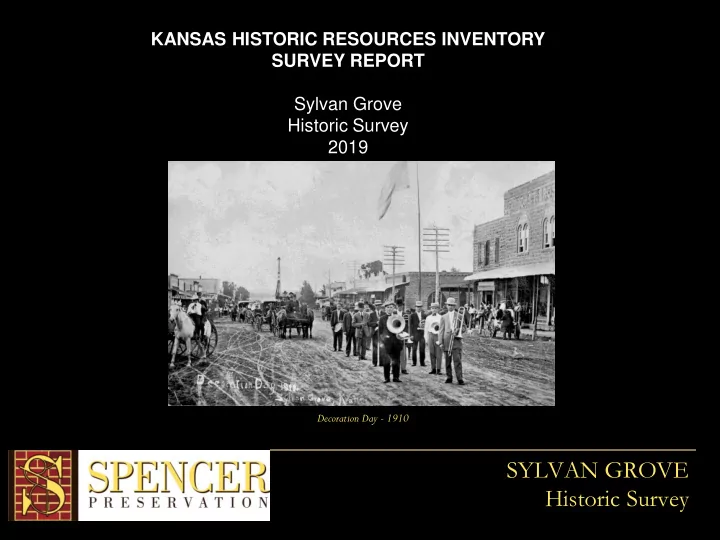

KANSAS HISTORIC RESOURCES INVENTORY SURVEY REPORT Sylvan Grove Historic Survey 2019 Decoration Day - 1910 SYLVAN GROVE Historic Survey
SYLVAN GROVE Historic Survey
https://khri.kansasgis.org/ SYLVAN GROVE Historic Survey
DO NOT USE BACK ARROW Click on column to sort Click on building to select that record SYLVAN GROVE Historic Survey
LINCOLN DOWNTOWN Historic Survey
SYLVAN GROVE Historic Survey
Dates of Construction: 1880s – 2000s The oldest resource surveyed was the Union Pacific Depot in 1887; the newest is the Rural Fire Department/EMS Building built in 2009. • 15% of the buildings surveyed were built before 1900 • 27% of the resources surveyed were constructed in the 1910s and 1920s • 24% were built in the 1930s and 1940s • 24% of the resources surveyed were constructed after WWII, three of which were constructed after 1970 and are less than fifty-years old, the basic threshold for historic consideration. SYLVAN GROVE Historic Survey
Architectural Styles 10% Prominent Late Victorian (1880s-1890s) SYLVAN GROVE Historic Survey
Late 19 th and Early 20 th Century Revival Styles And Progressive Era Commercial Style Buildings (27%) SYLVAN GROVE Historic Survey
Vernacular Designs – 24% SYLVAN GROVE Historic Survey
Modern Movement: 7% Post-WWII/Mid-Century Modern and 10% Utilitarian and Contemporary Resources SYLVAN GROVE Historic Survey
Classifications based on building form: One-Part and Two-Part Commercial Blocks include traditional storefront with upper facade with or without transom, display windows and base or bulkhead often with recessed entry SYLVAN GROVE Historic Survey
CONTRIBUTING/NON-CONTRIBUTING TO HISTORIC DISTRICT does NOT mean good and bad 50-year age threshold, 1969-1970 In order to be considered historically-significant ,a property must generally retain the physical features and original materials that define both why a property is significant and when it gained significance. Replacement of storefronts, windows, and even entire facades were common alterations of historic commercial buildings particularly during local boom years when merchants had money and were reinvesting in their buildings to attract new customers. It is the degree to which the past modifications were in keeping with the building’s historic character that determines the level of historic integrity a property retains, or whether the past modifications reflected a major design change that has gained significance in its own right. SYLVAN GROVE Historic Survey
There are a variety of reasons that a building could be identified as a non- contributor to a historic district or not eligible for listing including: built less than fifty years ago; removal or infill of glass storefront on traditional historic commercial building thereby changing the relationship of the building to the street front and passersby; infill or downsizing of upper windows on the front facade altering the proportions of the historic facade; or installation of siding covering street facades (obscuring historic fabric). Another major consideration is the streetscape – freestanding buildings
SYLVAN GROVE Historic Survey
SYLVAN GROVE Historic Survey
BENEFITS OF HISTORIC SURVEY First Step in considering designation of Historic District Based on number of “contributing” properties, Recommendation is to establish State Historic District In the recommended boundary for the KS historic district : Spans from Coop & Depot on south to station on N 36 resources 1 properties listed in the National Register, 20 deemed to be contributors to a potential State historic district, and 14 non-contributing buildings. Resulting in a total of 56% contributing buildings, a majority of the district resources. SYLVAN GROVE Historic Survey
WHY HISTORIC DISTRICT Financial Incentives for rehabilitation projects, building improvements and general maintenance Marketing and Heritage Tourism COMMON MISCONCEPTIONS “They” are going to make me to something to my building “They” are going to keep me from doing something I want to my building Requires public access All incorrect ….Review and Comment is extent of state involvement in what you do to your buildings even in a historic district, all power lies with local municipality who issues building permits SYLVAN GROVE Historic Survey
Preservation Education and Marketing • Take advantage of available incentives 25% KS Historic Tax Credit If you follow rules, you will get the credit • Heritage Trust Fund Grants 80/20; 60/40 matching grants $90,000 max competitive annual round (1 in 3 average) • Marketing – promote historic buildings as part of your identity – Heritage Tourism SYLVAN GROVE Historic Survey
Tax Credit Basics Tax credits provide a key tool for the rehabilitation of historic properties — The state program provides a tax credit equal to 25 percent of qualified expenditures on income-producing or non income- producing properties. Projects must meet the Secretary of the Interior's Standards for Rehabilitation SYLVAN GROVE Historic Survey
Tax Credit Basics – Quick and Dirty Rehabilitation Project Non- QRE Qualified Roof 22,500 New HVAC 10,000 New sign 400 Furniture/ Equipment 2,100 32,500 2,500 Rehab Cost (QRE) 32,500 25% KS Tax Credit x .25 8,125 sell tax credits at 90 cents 0.88 QRE 32,500 cash Non-qualified 2,500 toward 7,150 project Total Cost 35,000 Down payment on project costs after selling credit -7,150 Net cost of project when you 27,850 sell credit and put toward cost OR if using credit yourself 35,000 Full value of credit -8,125 Net cost of project if you 26,875 Apply tax savings to project SYLVAN GROVE Historic Survey
Scope of rehabilitation using HTC can be maintenance, repair , interior, or extensive SYLVAN GROVE Historic Survey
QUESTIONS? Kelly Larson, LCEDF Brenda Spencer: Brenda@SpencerPreservation.com 785-456-9857 LINCOLN COUNTY HISTORIC SURVEY PROJECT Historic Preservation Grant Kansas State Historical Society & National Park Service Lincoln County Economic Development Foundation THANK YOU
Recommend
More recommend